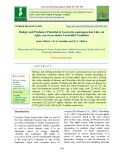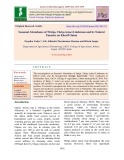
Coccinella septempunctata
-
Cannibalism or intraspecific predation, where one species feeds on individuals of its own species, is a widespread phenomenon in most aphidophagous coccinellids. Laboratory studies were conducted on the cannibalistic behavior of various developmental stages of Coccinella septempunctata L. (Coleoptera: Coccinellidae) in the presence and absence of natural food, Acyrthosiphon pisum (Harris) (Hemiptera: Aphididae). In both the presence and absence of aphids, the eggs and 1st and 2nd instars of C.
 7p
7p  dolomite36
dolomite36
 30-12-2021
30-12-2021
 11
11
 0
0
 Download
Download
-
Different natural enemies recorded from aphid colonies on rose included two coccinellid predators (Coccinella septempunctata and Cheilomenes sexmaculata), syrphid fly, spider (Oxyopes sp.) and chrysopid (Chrysoperla carnea). Among these, ladybird beetle, C. septempunctata followed by syrphid fly maggot was found to be the most abundant predator feeding on aphids colony.
 5p
5p  gaocaolon9
gaocaolon9
 22-12-2020
22-12-2020
 12
12
 2
2
 Download
Download
-
Field experiments were conducted during Rabi season of 2012-13 and 2013-14. The study revealed that the major natural enemies recorded were coccinellids, Coccinella septempunctata (Fab.), Cheilomenes sexmaculatus (Fab.) (Coleoptera: Coccinellidae); common green lacewing, Chrysoperla sp. (Neuroptera: Chrysopidae); aphid parasitoid, Diaeretiella sp. (Hymenoptera: Braconnidae); diamond back moth and tobacco caterpillar on parasitoid of Cotesia sp. (Hymenoptera: Braconidae).
 13p
13p  trinhthamhodang1215
trinhthamhodang1215
 23-09-2020
23-09-2020
 12
12
 2
2
 Download
Download
-
The present investigation on abundance of major insect-pests infesting green gram and its associated natural enemies was carried at Instructional farm and Department of Entomology, Rajasthan College of Agriculture, MPUAT, Udaipur. Green gram variety SML-668 was sown on 18th July during kharif 2015 and 16th July during kharif 2016 with the seed rate of 15 kg/ ha; maintaining a row to row and plant to plant spacing of 30 cm x 10 cm, respectively. Major insect pests, viz., aphids, Aphis craccivora (Koch); jassids, Empoassca spp.
 10p
10p  gaocaolon5
gaocaolon5
 14-06-2020
14-06-2020
 15
15
 1
1
 Download
Download
-
The peak population of mustard aphid on yellow sticky traps was recorded with 35.4±2.9 aphids/trap from 7th SW and it was active from 45th SW to 14th SW, where it was on peak with 712.4±16.4 aphids/plant under the field condition from untreated plots at 3rd SW. Coccinella septempunctatas active from 50th SW to 13th SW of the season and peak population noticed from 5th SW with 14±0.4 grubs and adults/plant.
 8p
8p  nguaconbaynhay5
nguaconbaynhay5
 16-05-2020
16-05-2020
 16
16
 0
0
 Download
Download
-
During survey a total of thirteen species were found belonging to orders viz. Coleoptera, Diptera, Hemiptera and Aranea. The maximum number (10) of species was found of the order coleoptera and maximum number of natural enemies was recorded on rose. The identified species of natural enemies were Coccinella septempunctata, Oenopia kirbyi, Oenopia sauzeti, Hippodamia variegata, Cheilomenes sexmaculata, Chilocorus infernalis, Coccinella transversalis, Coelophora bissellata, Metasyrphus confrater, Orius insidiosus and spiders.
 5p
5p  kethamoi4
kethamoi4
 16-04-2020
16-04-2020
 8
8
 1
1
 Download
Download
-
Succession of insect pest complex and their natural enemies in pigeonpea [Cajanus Cajan (L) Millsp.]
An experiment was conducted during kharif season 2015-2016 at experimental field, Department of Entomology, Live Stock Farm, Adhartal, Jawaharlal Nehru Krishi Vishwa Vidyalaya, Jabalpur (M.P.), to observe the “Succession of Insect Pest Complex and Their Natural Enemies in Pigeonpea [Cajanus Cajan (L) Millsp.]”. Result revealed that 17 species of insects (13 pest and 4 natural enemies) were observed in pigeonpea i.e. Jassids Empoasca fabae Harris, Cow bug Otinotus oneratus W., Pod bug Clavigralla gibbosa Spinola, Riptortus sp.
 10p
10p  trinhthamhodang3
trinhthamhodang3
 12-02-2020
12-02-2020
 13
13
 0
0
 Download
Download
-
Biology and feeding potential of Coccinella septempunctata was studied in the laboratory condition during 2013 in different months pertaining to different temperature regimes on Cowpea aphid, Aphis craccivora. During the cooler months of January and November, the life stages are prolonged and in the warmer months of March and May the life stages are shorter for the coccinellid. In January, when the mean temperature was 21.7ºC, the total developmental period from egg to adult stage, took 22.4±0.67 days whereas, in May, at 32.7ºC, the total developmental periods was 15.2±0.
 6p
6p  nguaconbaynhay3
nguaconbaynhay3
 07-02-2020
07-02-2020
 8
8
 0
0
 Download
Download
-
The investigations on Seasonal Abundance of thrips, Thrips tabaci Lindemen on Kharif onion and Its Management through Insecticides” were conducted at Horticulture farm, S.K.N. College of Agriculture, Jobner during Kharif, 2016. The incidence of thrips, T. tabaci on onion was commenced in the second week of August and reached to its peak in the second week of September. Whereas, the predator, Coccinella septempunctata Linn. was commenced in the second week of August and reached to maximum in the third week of September.
 4p
4p  cothumenhmong1
cothumenhmong1
 08-12-2019
08-12-2019
 12
12
 1
1
 Download
Download
-
Tiêu diệt côn trùng có hại gồm các nhóm côn trùng bắt mồi ăn thịt, ký sinh tiêu diệt các loài sâu hại. Một mặt chúng làm giảm số lượng cá thể các loài gây hại, mặt khác góp phần cân bằng hệ sinh thái. Thuộc các nhóm côn trùng này có Chuồn chuồn, Cánh cứng, Cánh màng, Hai cánh, Bọ ngựa và đặc biệt là ong ký sinh. Ví dụ như Bọ rùa châu Úc (Rdolia cardinalis) ăn rệp sáp hại cây (Icerya purchasi), Bọ rùa vằn (Coccinella repanda), Bọ rùa 7 chấm (Coccinella septempunctata), Bọ rùa 8 chấm...
 32p
32p  myxaodon07
myxaodon07
 01-06-2011
01-06-2011
 147
147
 26
26
 Download
Download
CHỦ ĐỀ BẠN MUỐN TÌM









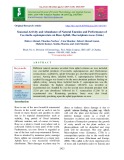
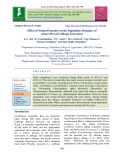
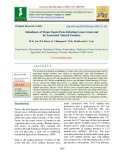
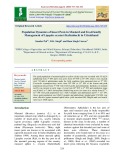
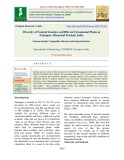
![Succession of insect pest complex and their natural enemies in pigeonpea [Cajanus Cajan (L) Millsp.] Succession of insect pest complex and their natural enemies in pigeonpea [Cajanus Cajan (L) Millsp.]](https://tailieu.vn/image/document/thumbnail/2020/20200212/trinhthamhodang3/135x160/1431581525164.jpg)
